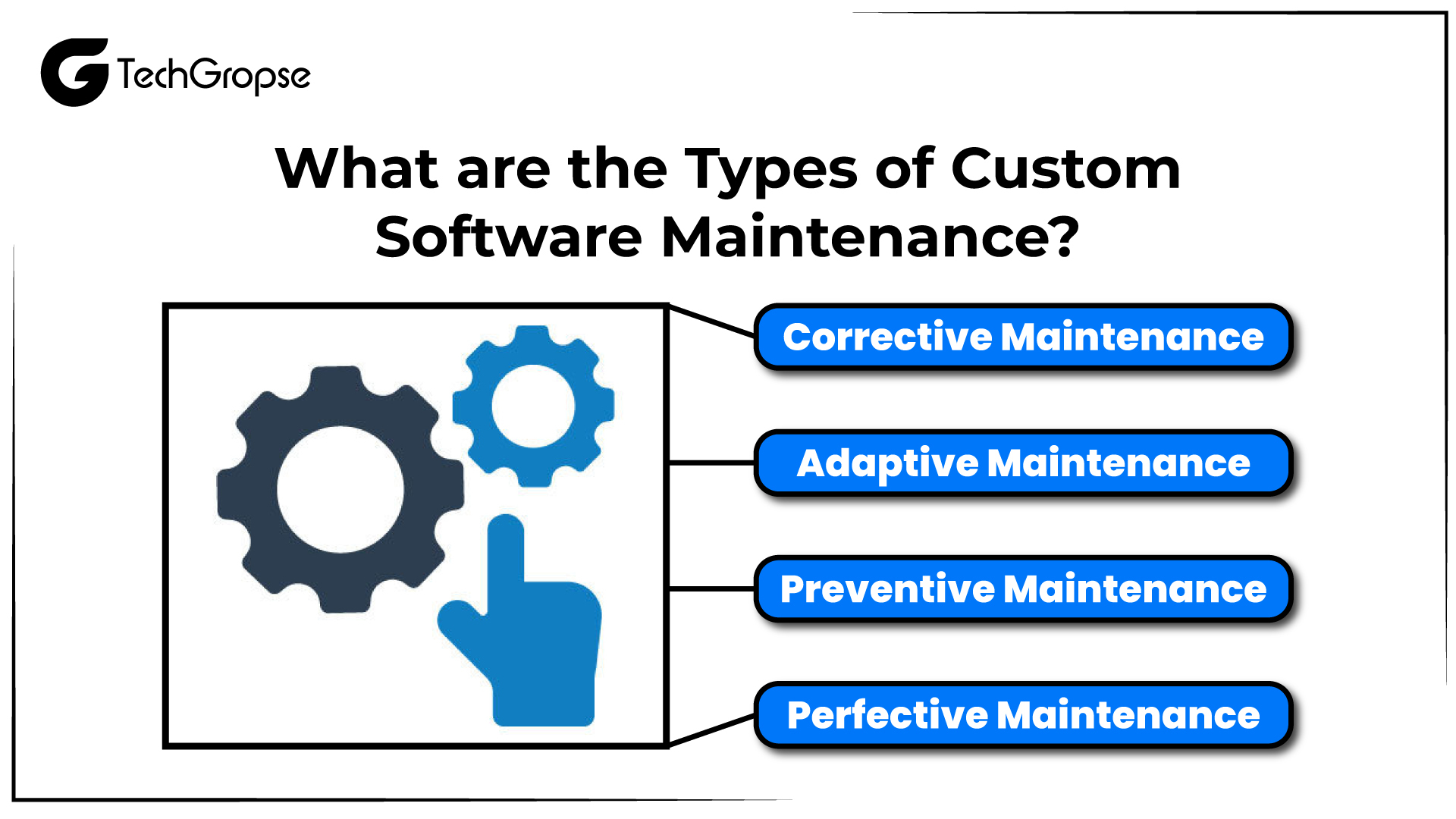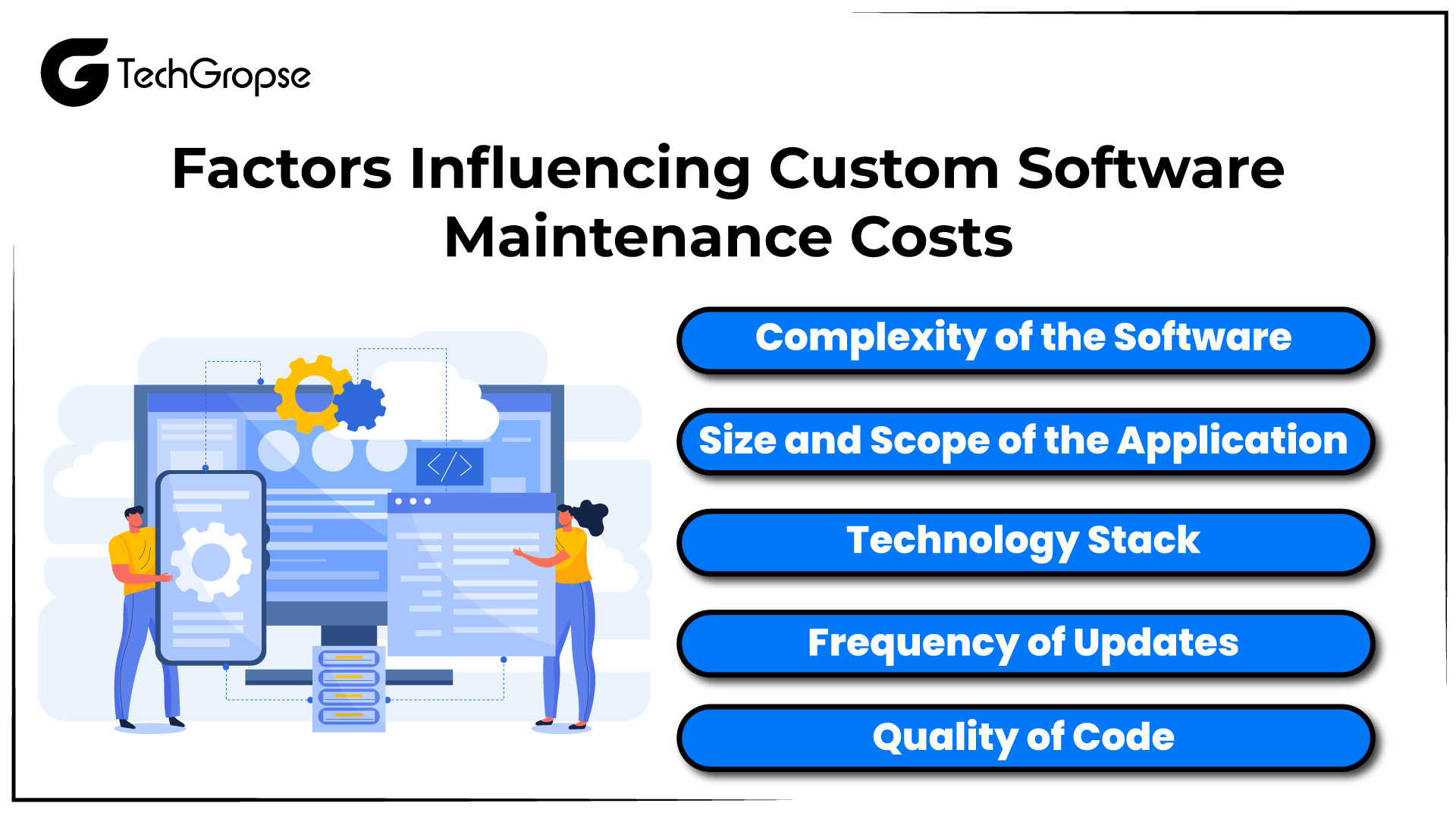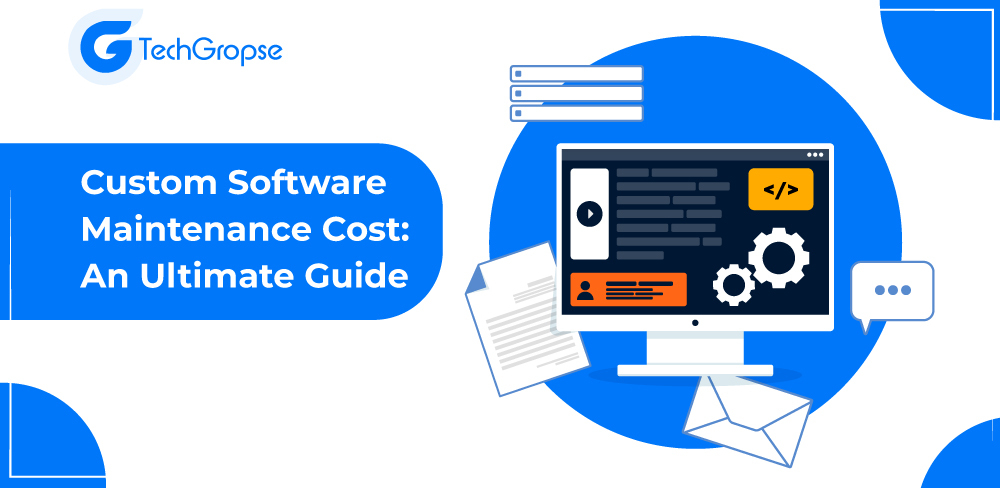You are probably wondering how much it costs to make custom software. Or what is custom software maintenance cost? Well, it is not a simple answer. The maintenance cost depends on various factors, like how complicated the project is, how long it takes to finish, and what exactly you want the software to do.
Software maintenance is vital, just like making the software in the first place. It helps make the software work better and be able to handle changes in the business world.
Even if you made good and safe software for your business, it can still have problems and mistakes over time. That’s when you need software maintenance to fix those problems.
| The global custom software development market was valued at $24.46 billion in 2021. It is expected to grow 22.3% CAGR from 2023 to 2030. |
But a lot of business owners don’t realize how important software maintenance is, so they only get software development services. Then, when the software starts having problems, they have to pay a lot of money to fix it.
That’s why software developers always say you should take care of the software, just like when you made it.
Let’s start to explore custom software development costs and essential factors to know more about it.
A Closer Look at Custom Maintenance Software Cost
Did you know that taking care of software is crucial? It’s like taking care of a pet or a plant – if you don’t give it the attention it needs, things can get pretty messy!
You might be thinking, “Why can’t I just build the software and forget about it?” Well, my friend, that’s wishful thinking. Custom software maintenance is crucial because, just like your car, software needs regular maintenance to stay in top shape.
It ensures that the software continues to function properly, remains secure, and adapts to changing business needs. Without proper maintenance, your software could turn into a clunky, outdated mess.
So, let’s talk about the custom software maintenance cost. On average, it usually costs around 15-20% of the license cost per year. The total cost can vary depending on different things.
We’ll get into those details later, don’t worry.
Now, if you decide to hire dedicated developers to take care of your software, it can cost you somewhere between $5 and $20 per hour. If you don’t maintain your software for a long time, the custom software maintenance cost can skyrocket. Experts say it can even be three times higher than the regular maintenance cost.
Why Software Maintenance is Important?
In 2025, more people are using smartphones in the US and it will increase by 311 million more. It means there are going many opportunities for people who make apps.
Now, when it comes to making these apps, a lot of attention is given to the custom software development part. It is not all glitz and glamour, It’s a lot of hard work and creativity.
But here’s the thing, the story doesn’t end once the app is done.
Nope, not at all!
Just like how we need to take care of our electronic devices, apps need to be maintained too. We keep an eye on how they are performing and make sure they get regular updates.
Imagine, you are watching an exciting movie and then suddenly, the screen goes blank. You paid for that movie and wanted a refund, you’d be pretty upset, right?
Well, the same goes for apps. People want to have a smooth and uninterrupted experience when they use them. That’s why it is important to regularly maintain your app.
If you don’t take care of your app and it starts acting up, it could even get removed. And nobody wants that, right?
So, make sure you keep your app in tip-top shape and give your users the best experience ever.
The Key Role of Software Maintenance in Maximizing Efficiency
In today’s rapidly evolving technological landscape, software has become an integral part of businesses across various industries.
However, simply deploying software solutions is not enough to ensure sustained efficiency and performance. Website development company believe software maintenance plays a crucial role. It helps to maximize the efficiency of systems and applications over their lifecycle.
Know the importance of software maintenance and its impact on optimizing efficiency in modern businesses.
Key Aspects of Software Maintenance
- Bug Fixing: Identifying and resolving software bugs is a primary objective of maintenance activities. Bug fixes address issues that may arise post-deployment, such as errors, crashes, or unexpected behavior, ensuring smooth operation and user satisfaction.
- Performance Optimization: Over time, software performance may degrade due to factors like increased data volume, inefficient algorithms, or hardware limitations. Maintenance efforts focus on optimizing performance through code refactoring, resource utilization improvements, and scalability enhancements.
- Security Updates: With the proliferation of cybersecurity threats, maintaining the security of software systems is paramount. Regular security updates and patches help address vulnerabilities, protect against malicious attacks, and safeguard sensitive data from breaches.
- Feature Enhancements: As user needs and market demands evolve, software applications must evolve accordingly. Custom software maintenance cost activities involve adding new features, functionalities, or integrations to enhance user experience, drive innovation, and maintain competitiveness.
- Compatibility Improvements: Software must remain compatible with evolving operating systems, devices, browsers, and third-party dependencies. Maintenance efforts ensure compatibility by updating libraries, APIs, and dependencies, thereby preventing compatibility issues and ensuring seamless operation across platforms.
The Impact of Software Maintenance on Efficiency

Organizations that prioritize software maintenance can reap the benefits of enhanced productivity, cost savings, and competitive advantage, positioning themselves for long-term success in today’s digital economy.
- Enhanced Reliability: Regular maintenance activities such as bug fixing and performance optimization improve the reliability and stability of software applications, reducing downtime and enhancing user trust and satisfaction.
- Increased Productivity: Efficient software systems enable employees to perform their tasks more effectively and efficiently, leading to improved productivity and business outcomes. By addressing usability issues and streamlining workflows, maintenance efforts contribute to enhanced operational efficiency.
- Cost Savings: Proactive software maintenance helps prevent costly system failures, data breaches, and productivity losses associated with downtime. Investing in maintenance activities upfront can lead to long-term cost savings by mitigating risks and prolonging the lifespan of software assets.
- Competitive Advantage: Businesses that prioritize software maintenance can stay ahead of the competition by continuously improving their products, responding to market changes, and delivering superior customer experiences. A well-maintained software ecosystem enables organizations to innovate faster, adapt to emerging trends, and seize new opportunities.
- Long-Term Sustainability: Software maintenance is essential for ensuring software assets’ long-term sustainability and viability. By keeping applications up-to-date, secure, and aligned with business objectives, organizations can extend the lifespan of their investments and maximize their return on investment (ROI) over time.
How Much Does Custom Software Maintenance Cost?
Software maintenance encompasses all activities aimed at ensuring the continued effectiveness and reliability of software applications after deployment.
It involves various tasks, including bug fixing, performance optimization, security updates, feature enhancements, and compatibility improvements.
Effective software maintenance strategies are essential for addressing evolving user requirements, adapting to technological advancements, and mitigating risks associated with software failures.
| Cost Factor | Description | Estimated Cost Range |
| Bug Fixes | Identification and resolution of software bugs | $500 – $2,000 per fix |
| Performance Optimization | Optimization of software performance | $1,000 – $5,000 per month |
| Security Updates | Regular updates to address security vulnerabilities | $2,000 – $10,000 per year |
| Feature Enhancements | Addition of new features and functionalities | $3,000 – $15,000 per feature |
| Compatibility Updates | Updates to ensure compatibility with new platforms | $1,000 – $5,000 per update |
*Please note that these custom software maintenance cost estimates are approximate and can vary based on factors. It includes the complexity of the software, the frequency of maintenance tasks, and software developers’ cost or maintenance service providers. It’s essential to consult with a custom software development company or service provider to obtain accurate custom software maintenance cost estimates tailored to your project needs.
What are the Types of Custom Software Maintenance?

The software development process can be categorized into four different types. While undergoing software maintenance services, a product has to undergo one or more types of maintenance.
1. Corrective Maintenance
Corrective maintenance is like playing detective – it involves fixing bugs and resolving issues that arise during software operation. It’s all about keeping things running smoothly and preventing any gremlins from wreaking havoc on your software.
2. Adaptive Maintenance
Adaptive maintenance is all about staying flexible. It involves modifying the software to keep up with changes in the business environment, user requirements, or technology. So, if your business takes a sharp turn or technology goes into hyperdrive, adaptive maintenance has got your back.
3. Perfective Maintenance
Perfective maintenance is like a makeover for your software. It focuses on improving the software’s performance, usability, and efficiency without adding new features. It’s all about making your software shine brighter than a disco ball.
4. Preventive Maintenance
Preventive maintenance is like taking your software for regular check-ups. It involves proactive measures to detect and fix potential issues before they become actual problems. Think of it as your software’s annual physical exam.
Factors Influencing Custom Software Maintenance Costs

Understanding these factors is essential for estimating and managing custom software maintenance costs effectively.
By considering these variables during the planning and development stages, organizations can make informed decisions.
It allocates resources appropriately to ensure the long-term sustainability and success of its software applications.
1. Complexity of the Software
The complexity of the software architecture, design, and functionality significantly impacts maintenance costs. Complex systems may require more extensive testing, debugging, and refactoring, leading to higher maintenance expenses.
2. Size and Scope of the Application
The size and scope of the software application influence maintenance costs. Larger applications with more extensive codebases and a greater number of features generally require more effort and resources to maintain. You can hire web developers to know accurate custom software maintenance cost.
| Application Size | Maintenance Cost (per month) |
| Small | $500 – $2,000 |
| Medium | $2,000 – $5,000 |
| Large | $5,000 – $10,000 |
| Enterprise | $10,000+ |
3. Technology Stack
The choice of the technology stack used to develop the software can affect custom software maintenance cost. Technologies that are less common or require specialized expertise may incur higher maintenance expenses due to the limited availability of skilled professionals or higher hourly rates.
4. Frequency of Updates
The frequency of updates and changes to the software impact custom software maintenance cost. Applications that require frequent updates, bug fixes, or feature enhancements may incur higher ongoing maintenance expenses compared to those with less frequent updates.
5. Quality of Code
The quality of the original codebase influences web development cost. Well-structured, modular code that follows best practices is easier to maintain and requires fewer resources for debugging and troubleshooting, resulting in lower maintenance costs over time.
Related reading: how much does custom software development cost in atlanta
Look At the Additional Factors That Affect Custom Software Maintenance Cost
1. External Dependencies
Software applications often rely on third-party libraries, frameworks, APIs, and other external dependencies. Changes or updates to these dependencies can impact maintenance costs, particularly if they introduce compatibility issues or security vulnerabilities that need to be addressed.
2. Security Requirements
The level of security required for the software application affects maintenance costs. Applications that handle sensitive data or operate in regulated industries may require more extensive security measures, such as regular security audits, penetration testing, and compliance assessments, leading to higher maintenance expenses.
3. Regulatory Compliance
Compliance with industry regulations and standards may impact maintenance costs. Applications subject to regulatory requirements must undergo regular audits, updates, and documentation to ensure compliance, which can increase maintenance expenses.
4. Support and Service Level Agreements (SLAs)
The level of support and service provided by the maintenance provider influences costs. Service level agreements specifying response times, resolution times, and support availability may incur additional fees or affect the overall cost structure of maintenance contracts.
5. Geographical Location
The geographical location of maintenance providers and mobile app developers can impact costs due to differences in labor rates, overhead expenses, and market conditions. Maintenance services sourced from regions with lower labor costs may offer cost savings compared to providers in higher-cost regions.
Best Practices for Effective Custom Software Maintenance
1. Establishing a Maintenance Plan
Just like your car needs regular check-ups, your custom software also benefits from a maintenance plan. By establishing a dedicated schedule for maintenance tasks, you ensure that necessary updates and bug fixes are addressed promptly. It’s like giving your software a calendar with reminders to keep it healthy and running smoothly.
2. Prioritizing and Managing Bug Fixes
Bugs are like pesky little critters that can derail your software’s performance. That’s why it’s important to prioritize and manage bug fixes effectively. By categorizing bugs based on severity and impact, you can focus your resources on resolving the most critical issues first. It’s like tackling the biggest problems head-on, ensuring that your software stays resilient.
3. Ensuring Compatibility and Upgrades
In the ever-evolving landscape of technology, compatibility is crucial. As new operating systems, frameworks, and tools emerge, it’s essential to ensure that your custom software stays up to date. By regularly evaluating compatibility and implementing necessary upgrades, you can avoid costly breakdowns and compatibility issues down the line. It’s like keeping your software on its toes, ready to adapt and thrive in any environment.
4. Monitoring and Analyzing Software Performance
Just like athletes track their progress, monitoring and analyzing software performance is essential for maintaining optimal functionality. By continuously monitoring key performance indicators, you can proactively identify bottlenecks, optimize resource usage, and improve overall efficiency. It’s like having your software coach, guiding it towards peak performance.
Final Thought
Custom software maintenance is a critical investment that organizations must make to ensure the continued functionality and effectiveness of their software systems.
By considering the factors influencing custom software maintenance costs, implementing cost-saving strategies, and following best practices, businesses can minimize expenses while maximizing the value derived from their software.
Embracing proactive maintenance approaches and staying ahead of potential issues can lead to enhanced user satisfaction, improved system performance, and increased competitiveness in today’s rapidly changing technological landscape.
By prioritizing custom software maintenance, organizations can achieve long-term success and derive the maximum value from their software investments.
Related reading: how much does custom software development cost in chicago
FAQ: Custom Software Maintenance Cost
Q: Why is the software maintenance cost higher than the development cost?
Software maintenance costs can exceed development costs due to several factors. Maintenance involves ongoing activities like bug fixes, updates, and support, which require continuous effort and resources. Additionally, as software ages, its complexity increases, making maintenance more challenging and time-consuming.
Q: Is custom software expensive?
Custom software development can be expensive, depending on various factors such as the complexity of the project, the required features, and the expertise of the development team. While off-the-shelf solutions may seem cheaper initially, custom software offers tailored solutions that can provide long-term cost savings and efficiency gains.
Q: How can organizations estimate custom software maintenance costs?
Estimating custom software maintenance costs involves considering various factors such as the complexity of the software, the volume of code, the number of anticipated updates, the required skill sets of the maintenance team, and any potential risks or challenges. Different estimation techniques like function point analysis or expert judgment, along with tools and resources, can help organizations estimate maintenance costs more accurately.
Q: What are some strategies to reduce custom software maintenance costs?
To reduce custom software maintenance costs, organizations should focus on regular code maintenance and refactoring to improve code quality and reduce the occurrence of bugs. Implementing continuous testing practices and ensuring comprehensive quality assurance can also help identify and address issues early on, minimizing maintenance efforts.










